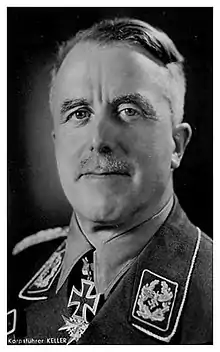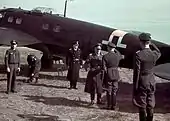Alfred Keller
Alfred Keller (19 September 1882 – 11 February 1974) was a general in the Luftwaffe of Nazi Germany during the Second World War who commanded the Luftflotte 1. His career in the Imperial German Armed Forces began in 1897; he served as a bomber pilot in World War I.
Alfred Keller | |
|---|---|
 Keller as NSFK Korpsführer | |
| Born | 19 September 1882 Bochum |
| Died | 11 February 1974 (aged 91) Berlin |
| Buried | |
| Allegiance | |
| Service/ | |
| Years of service | 1902–45 |
| Rank | |
| Commands held | Luftflotte 1 |
| Battles/wars | World War I
World War II |
| Awards | Pour le Mérite Knight's Cross of the Iron Cross |
World War II

In September 1939, when the Second World War begun, then General Alfred Keller commanded the 4th Air Corps during the invasion of Poland, assuming this command on 13 October 1939. The following campaigns, during campaigns against Norway, the Netherlands, Belgium and the Battle of France, he commanded Luftflotte 2 with General Albert Kesselring as his superior. Keller was awarded the Knight's Cross of the Iron Cross (Ritterkreuz des Eisernen Kreuzes) on 24 June 1940 as commander of the 4th Air Corps. Shortly afterwards, on 19 July 1940, he was promoted Generaloberst. On 19 August 1940, during the Battle of Britain, Alfred Keller was appointed as the commander of Luftflotte 1 and Air Force commander - East. Keller led this formation very energetically during the invasion of the Balkans Campaign and later during the Operation Barbarossa where he predominantly supported Army Group North. Keller remained with Luftflotte 1 until 12 June 1943, when he retired from active service at the age of 61, replaced by the 16 years younger Günther Korten. However, he continued to perform important functions in National Socialist Flyers Corps (Nationalsozialistische Fliegerkorps; NSFK), a paramilitary unit that he organised to form a civil reserve of pilots. He was Korpsführer of the NSFK from 26 June 1943, until the German surrender on 8 May 1945. Towards the end of the war Keller was responsible for the antitank weapons department of the Luftwaffe. Keller was a committed National Socialist and his command appointments were due to Hermann Göring's favour rather than his military acumen.
Later life
With the German capitulation on 8 May 1945, Keller became a British prisoner, being kept as a POW until 1947. In the 1950s he became one of the first presidents of the Association of Knight's Cross Recipients. Keller died in Berlin. He was buried at the Waldfriedhof Zehlendorf.[1]
Awards
- Knight's Cross of the Iron Cross on 24 June 1940 as General der Flieger and commanding general of the IV. Fliegerkorps[2][3]
References
Citations
- Mende 2018, p. 634.
- Scherzer 2007, p. 435.
- Fellgiebel 2000, p. 252.
Bibliography
- Cooper, Matthew (1981). The German Air Force 1933–1945: An Anatomy of Failure. New York: Jane's. ISBN 0-531-03733-9.
- Corum, James (1997). The Luftwaffe: Creating the Operational Air War, 1918–1940. Kansas University Press. ISBN 978-0-7006-0836-2.
- Corum, James (2008). Wolfram von Richthofen: Master of the German Air War. Lawrence: University Press of Kansas. ISBN 978-0-7006-1598-8.
- Fellgiebel, Walther-Peer (2000) [1986]. Die Träger des Ritterkreuzes des Eisernen Kreuzes 1939–1945 — Die Inhaber der höchsten Auszeichnung des Zweiten Weltkrieges aller Wehrmachtteile [The Bearers of the Knight's Cross of the Iron Cross 1939–1945 — The Owners of the Highest Award of the Second World War of all Wehrmacht Branches] (in German). Friedberg, Germany: Podzun-Pallas. ISBN 978-3-7909-0284-6.
- Frieser, Karl-Heinz (2005). The Blitzkrieg Legend: The 1940 Campaign in the West. Annapolis: Naval Institute Press. ISBN 978-1-59114-294-2.
- Hooton, Edward (1994). Phoenix Triumphant: The Rise and Rise of the Luftwaffe. Arms & Armour. ISBN 978-1-85409-181-9.
- Hooton, E.R. (1997). Eagle in Flames: The Fall of the Luftwaffe. Weidenfeld Military. ISBN 978-1-85409-343-1.
- Hooton, E.R. (2007a). Luftwaffe at War; Gathering Storm 1933–39. 1. London: Chevron/Ian Allan. ISBN 978-1-903223-71-0.
- Hooton, E.R. (2007b). Luftwaffe at War; Blitzkrieg in the West. 2. London: Chevron/Ian Allan. ISBN 978-1-85780-272-6.
- Mende, Hans-Jürgen (2018). Lexikon Berliner Begräbnisstätten [Lexicon of Berlin Burial Sites] (in German). Berlin, Germany: Pharus-Plan. ISBN 978-3-86514-206-1.
- Mitcham, Samuel (2007). Eagles of the Third Reich: Men of the Luftwaffe in World War II. Stackpole. ISBN 0-8117-3405-6.
- Scherzer, Veit (2007). Die Ritterkreuzträger 1939–1945 Die Inhaber des Ritterkreuzes des Eisernen Kreuzes 1939 von Heer, Luftwaffe, Kriegsmarine, Waffen-SS, Volkssturm sowie mit Deutschland verbündeter Streitkräfte nach den Unterlagen des Bundesarchives [The Knight's Cross Bearers 1939–1945 The Holders of the Knight's Cross of the Iron Cross 1939 by Army, Air Force, Navy, Waffen-SS, Volkssturm and Allied Forces with Germany According to the Documents of the Federal Archives] (in German). Jena, Germany: Scherzers Militaer-Verlag. ISBN 978-3-938845-17-2.
| Military offices | ||
|---|---|---|
| Preceded by Generalmajor Hellmuth Bieneck |
Commander of 4. Flieger-Division 1 February 1939 – 11 October 1939 |
Succeeded by IV. Fliegerkorps |
| Preceded by 4. Flieger-Division |
Commander of IV. Fliegerkorps 11 October 1939 – 19 August 1940 |
Succeeded by General der Flieger Kurt Pflugbeil |
| Preceded by General Wilhelm Wimmer |
Commander of Luftflotte 1 20 August 1940 – 12 June 1943 |
Succeeded by Generaloberst Günther Korten |